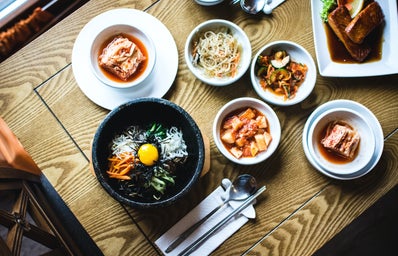The very first time I felt homesick after moving out was during my first meal alone.
I had yet to make any friends, despite everyone telling me how easy it was to make friends and socialize in college, and I was eating alone in the dining hall. It was quiet, because I had successfully avoided the lunch rush and was early enough before the dinner crowds arrived. I was eating a bowl of white rice and some sort of vegetable stir-fry. The label said that it had an “Asian-inspired” sauce.
It was the closest dish I found that reminded me of home, and yet it wasn’t even accurate. Though I did not expect an equivalent to my mother’s cooking at the C4C, it was still upsetting when I tried to compare it to the meals I would have at home. The rice was dry and pebbly and it made me miss the rice cooker that sits on our kitchen counter at home- always full of steaming hot sticky white rice. The sauce was too sweet and tasted more like the orange chicken from Panda Express–tasty, but not authentic or what I needed at the moment. I noticed that the onions were not finely chopped and the broccoli was not peeled. The carrots were cut differently and the peas had a different seasoning than my mother used. It wasn’t a bad meal, and it did not have much significance to me at the moment other than triggering some homesickness. However, my parents could tell I was struggling to adapt to my new environment, and after visiting home one weekend they surprised me with a bunch of home cooked meals, frozen and packaged up for me to take back to school.
I didn’t realize just how much food meant to me until I began to microwave the frozen wanja jeon and rice. If I closed my eyes and tried really hard, it was like being back at home, cooking with my mother after I got back from school.
Food is commonly portrayed as a sort of unofficial love language in many cultures. The stories about children being embarrassed about their ethnic lunches at American schools, sliced fruit as an apology, and family dinners silently mending the wounds created by arguments are all too well known. It’s become so popular in Asian-American media that some content creators have actually breached the topic of avoiding discussing our relationships with food, because somehow it has turned into reducing our culture to food alone. It has become trendy to eat foods like tteokbokki and ramen, and the media echoes with stories of Asian kids being bullied at school for bringing kimbap or curry for lunch–so why do we still keep talking about it? Those bullies that told us curry looked like vomit are now frequenting the nearest Indian restaurants. The girl that gagged at my oxtail bone soup is now following Gwyneth Paltrow’s bone broth diet. They’ve moved on, so why haven’t we?
Truthfully, wounds like that don’t heal overnight. Stories like these are what make the American immigrant experience so unique. Koreans who live in Korea do not experience the same struggles that Korean-Americans do. The same goes for any other ethnicity.
Though food is not the entirety of Korean culture, it holds a lot of importance. Personally, I do relate to all of the bullying stories I have heard about so many other Asian-Americans, and I don’t want to stop talking about it. I think that there is a possibility of a balance between bonding through shared experiences, in this case food, and diluting our heritage to trends and white acceptance. Though it sounds obvious, it’s easier said than done when applying that mindset to an entire demographic, and some people are clearly still struggling to find that balance. I myself struggled with internalized racism and a lot of self-hatred for many years, and I know how painful it is.
But like I said, I think sharing our experiences is a good thing. Back in September the Korean holiday Chuseok, often called the “Korean Thanksgiving,” came and went. I was not at home nor did I have any access to the foods that I would have enjoyed with my family, so I ate a peanut butter and jelly sandwich by myself in my room, looking at all the photos my family sent me. Here are a few of my favorite Korean foods I have missed most after moving out:
- Jeon 전 (pancakes)
There are tons of different kinds of jeon, but on Chuseok my family always makes five kinds: crab, fish, beef, zucchini, and green onion. Every kind is made somewhat similarly, with the base either being eggs or Korean pancake mix, and the other ingredients being mixed in and then fried into little patties. My favorite kinds are the beef and green onion ones, called wanja jeon (완자전) and pajeon (파전).
- Tteokbokki 떡볶이 (spicy rice cakes)
Though this is one of the dishes that has become much more well-known since Korean culture became more popularized in the West, my family makes a different kind of tteokbokki. Most people know tteokbokki as little tube-shaped rice cakes covered in a spicy sweet red sauce–sometimes with cream and cheese, in which case it would be called rose tteokbokki. My mom likes to make Gungjung tteokbokki, which is not spicy at all. The sauce mainly consists of soy sauce and mirin, a type of rice wine vinegar. The spicy version is often referred to as “street food” since it’s commonly sold by vendors and associated with other street foods like eomuk and odeng (fish cakes in broth) and mandu (Korean dumplings).
- Sokkoritang 소꼬리탕 (oxtail bone soup)
This is my favorite dish to eat on a cold winter day. It sounds a little odd at first, especially if the only reason you know of bone broth is because of Gwyneth Paltrow, but sokkoritang is delicious and soothing. This is one of the dishes that I only ever eat at home, because even the best Korean restaurants in Colorado cannot compete with my mother’s cooking. My favorite part is the mu (Korean radish) but I know that most people can’t get enough of the tender meat that falls off the bone.
- Kimchi jjigae 김치찌개 (kimchi stew)
I had dreams about my mom’s kimchi jjigae when I first moved out. It’s a hot, salty stew that you absolutely cannot have with a steaming bowl of white rice. Though it’s meant to be really spicy, my mom always puts less spice and uses white kimchi for a milder version since my dad can’t handle too much 고추가루 (Korean red chili pepper flakes).
- Bossam 보쌈 (pork wraps)
Similarly to jeon, there’s several different versions of ssam. The bossam recipe I linked has pickled lettuce leaves and shrimp, but I only ever eat it with fresh lettuce leaves and grilled pork (instead of boiled). There’s variety in the wraps (lettuce leaves, perilla leaves, napa cabbage) as well as the fillings, so my family has always treated it like an individual preference.
- Doenjang jjigae 된장찌개 (fermented soybean paste stew)
This is one of my favorite stews/soups. Again, the name in English might sound a little surprising to some people, but doenjang jjigae is another one of my favorite dishes for the colder months. In fact, in Maangchi’s recipe she mentions grown children reminiscing on their mother’s doenjang jjigae, and I definitely do that every time I’m away from home. This is also one of the only ways I like to eat zucchini, so my mom would often make this dish to make me eat my vegetables when I was a kid.
- Dakdoritang 닭도리탕 (spicy braised chicken stew)
This is my dad’s favorite dish to make. As previously mentioned, he can’t handle spice well so he always makes a mild version of this, but it’s just as delicious. In fact, I prefer it that way because it reminds me of him. This was one of the hardest things to give up when I was a vegetarian, because I knew how much love he put into the dish when he was cooking it and it broke my heart that I couldn’t eat it with him. There’s that darn sob story about Asian parents showing love through food again.
- Naengmyeon 냉면 (cold noodles in broth)
Okay to be fair, I don’t miss this dish that often because I ate it so often over the past summer. My mother only likes to make naengmyeon in the warmer months because it is often served in ice-cold broth, in which it’s called mul naengmyeon. I prefer bibim-naengmyeon, which is a spicy version with less broth.
- Samgyetang 삼계탕 (ginseng chicken soup)
If I had to choose only one Korean stew/soup to eat for the rest of my life, it would be this one. I talked about how sokkoritang is my favorite thing to eat on a cold day, and how I had dreams about kimchi jjigae, but samgyetang is a childhood favorite of mine. Store-bought chicken soup has been ruined for me forever because of my mother’s samgyetang.
- Banchan 반찬 (side dishes)
There are endless Korean side dishes that I could talk about forever, but these are a necessity with every meal. My current struggle meals are made up of instant rice/noodles and some form of banchan, sent from home. They’re so versatile because there are so many different kinds, and I am certain that there is a type of banchan for everyone. My personal favorites are kkaenip kimchi (pickled perilla leaves), jangjorim (braised beef in soy sauce), and oi muchim (spicy cucumbers).
Despite the recent saddening controversies over discussions of food in Asian-American media, I think it is important to share our cultures whilst being respectful of others. Some may disagree with my strong emotions when it comes to food, but it will always hold a lot of meaning to me, and that will never change.


